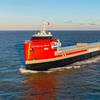UASC Challenges Top Players
Although the top 12 ocean carriers in the world today look set to continue dominating the market up to at least the end of 2014, UASC’s recent newbuild order will propel it up the ladder in a startling way.
United Arab Shipping Company’s confirmation last week that it has ordered five 18,000 vessels and five 14,000 teu vessels for delivery between late 2014 and mid-2015 is the first major challenge to the top players’ vessel capacity supremacy since Coscon and CSCL burst into the container market in the late 1990s. It will increase UASC’s vessel capacity offered at the end of last year by around 60%, and propel it from the bottom of the top 20 league to the lower ranks of the top 12.
The vessel order confirms that UASC intends to expand its presence between Asia and Europe, although how it will be achieved remains unclear. The timing of deliveries means that the five 18,000 vessels could combine with CSCL’s five 18,400 teu vessels into another major weekly string between Asia and Northern Europe, for example. At present, UASC provides only three 13,300 teu vessels in the AEC8’s weekly service between Asia and Northern Europe, which is shared with six 14,100 teu ships provided by CSCL and one 12,600 teu vessel from CMA CGM. The schedule includes a westbound and eastbound call at Jeddah.
A further two 13,296 teu UASC vessels form part of its shared AEC2 service with CMA CGM and MSC, which deploys a total fleet of 11 vessels between 13,296 teu and 16,000 teu and includes eastbound calls at both Khor Fakkan and Jebel Ali.
In the Asia/Mediterranean tradelane, seven UASC vessels of 6,920 teu form part of the AMC1/AMX1 fleet of 10 vessels, with CSCL’s providing three 8,500 teu ships. The schedule also includes eastbound calls at both Jeddah and Khor Fakkan.
Outside of the Asia/Europe tradelane, a wide range of other schedules include three 13,296 teu vessels deployed in the AGX1 service between Asia and the Mid-East.
Up to the time that UASC’s order was confirmed last week, the top 12 appeared to be coasting towards even greater supremacy, with approximately 61% of all vessel capacity (cellular and other vessels) already under their control towards the end of 2012.
Moreover, they control approximately 55% of all cellular capacity delivered or to be delivered this year, and at least 59% of all ordered cellular vessel capacity due for delivery in 2014 (see Table below). The figure is difficult to define as an increasing number of vessels are being ordered by tramp vessel owners, as explained in ‘Ocean carriers continue to become asset lighter’ (CIW August 4, 2013), and it is not always clear to whom they will be leased/chartered.
The top 12 also clearly have their eyes set on further vessel upgrades from between 10,000 teu and 13,000 teu to between 14,000 teu and 18,000 teu due to the economies of scale offered by the bigger vessels, as explained in ‘Why size matters’ (CIW September 2, 2013).
They will not be sweating too much over UASC’s order, therefore. Apart from the fact that it will add unwanted capacity to the global fleet, the Mid-East based state-owned carrier only controlled 1.5% of all vessel container capacity in October last year, and will still control less than 2% at the end of 2014, when the first vessels are due for delivery.
However, it does mean that the market is set to become more influenced by state-controlled liner companies, such as Coscon, CSCL and APL. Other Asian ocean carriers are also influenced by state interests through discrete ‘soft’ loans.
Drewry believes UASC will seek to join forces with other like-minded ocean carriers in the Asia/Europe tradelane in order to establish enough service frequency to take on the remaining big players.
drewry.co.uk









